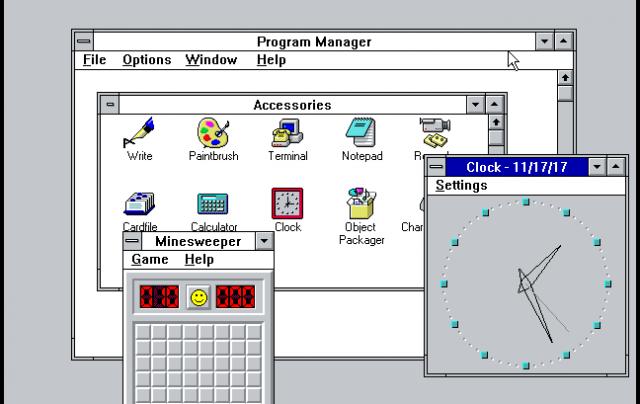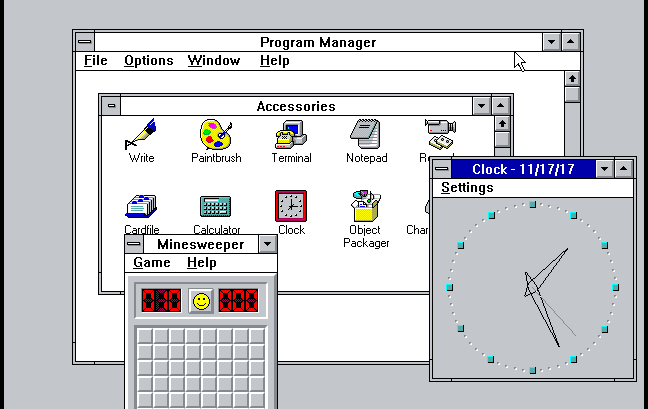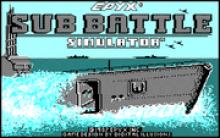Windows 3.11
Press Keyboard right side: Alt+Enter keys to switch to full screen game play, and Alt+Enter keys to return.
How to play Windows 3.11
Uses mouse and keyboard/ Takes a while to load be patient! runs faster if page is reloaded (not refresh) after the first loading.
Windows 3.11 Description
Windows 3.1x is a series of 16-bit operating systems produced by Microsoft for use on personal computers. The series began with Windows 3.1, which was first sold during March 1992 as a successor to Windows 3.0. Further editions were released between 1992 and 1994 until the series was superseded by Windows 95.
Base version
Windows 3.1 (originally codenamed Janus,[citation needed] of which two betas were published), released on April 6, 1992, includes a TrueType font system (and a set of highly legible fonts), which effectively made Windows a viable desktop publishing platform for the first time. Similar functionality was available for Windows 3.0 through the Adobe Type Manager (ATM) font system from Adobe.
Windows 3.1 was designed to have backward compatibility with older Windows platforms. As with Windows 3.0, version 3.1 had File Manager and Program Manager, but unlike all previous versions, Windows 3.1 and later support 32-bit disk access, cannot run in real mode, and included Minesweeper instead of Reversi (though Reversi was included in some copies).
Windows 3.1 Multimedia PC Version (Beta only, released Nov 1992 — codenamed Bombay) Included a media viewer, and the ability to play video files. It was targeted to the new multi-media PC and included sound and video integration with CD-ROM support.
Versions with special font support
A special version named Windows 3.1 for Central and Eastern Europe was released that allowed the use of Cyrillic and had fonts with diacritical marks characteristic of Central and Eastern European languages. Microsoft introduced its own codepage (Windows-1250) and supported its use in violation of many countries' ISO standards (e.g., the official Polish codepage is ISO-8859-2, which was ignored by Microsoft but is supported by contemporary Internet Explorer versions). Similarly, Microsoft also released Windows 3.1J with support for the Japanese language, which shipped 1.46 million copies in its first year on the market (1993) in Japan.
Windows 3.11
On December 31, 1993, Microsoft released an update for Windows 3.1 known as Windows 3.11. Thus, Windows 3.11 is not a standalone version of Windows, but rather a software update from Windows 3.1, much like modern Windows service packs. For those who did not own Windows 3.1, full disk sets of Windows 3.11 were available at the time.
Modular Windows
Modular Windows is a special version of Windows 3.1, designed to run on the Tandy Video Information System.
Windows 3.2
In 1993, Microsoft released a Simplified Chinese version of Windows for the Chinese market. The updated system identified itself as Windows 3.2. Thus, Windows 3.2 is the Chinese version of Windows 3.11. The update was limited to this language version, as it fixed only issues related to the complex writing system of the Chinese language.
Windows 3.2 was generally sold by computer manufacturers with a ten-disk version of MS-DOS that also had Simplified Chinese characters in basic output and some translated utilities.
Windows for Workgroups
Network capabilities of Windows for Workgroups 3.11
Windows for Workgroups is an extension that allowed users to share their resources and to request those of others without a centralized authentication server. It used the SMB protocol over NetBIOS.
Windows for Workgroups 3.1 (originally codenamed Winball and later Sparta), released in October 1992[4], features native networking support. Windows for Workgroups 3.1 is an extended version of Windows 3.1 that comes with SMB file sharing support via the NetBIOS based NBF and/or IPX network transport protocols, includes the Hearts card game, and introduced VSHARE.386, the Virtual Device Driver version of the SHARE.EXE Terminate and Stay Resident program.
Windows for Workgroups 3.11 (originally codenamed Snowball) was released on August 11, 1993, and shipped in November 1993. It supported 32-bit file access, full 32-bit network redirectors, and the VCACHE.386 file cache, shared between them. The standard execution mode of the Windows kernel was discontinued in Windows for Workgroups 3.11.
A Winsock package was required to support TCP/IP networking in Windows 3.x. Usually third-party packages were used, but in August 1994, Microsoft released an add-on package (codenamed Wolverine) that provided TCP/IP support in Windows for Workgroups 3.11. Wolverine was a 32-bit stack (accessible from 16-bit Windows application via WinSock thunks), which gave it superior performance to most of the third-party TCP/IP Windows stacks available. However, it was only compatible with Windows for Workgroups 3.11, and lacked support for dial-up. The Wolverine stack was an early version of the TCP/IP stack that would later ship with Windows 95, and provided an early testbed for the 16-to-32-bit compatibility layer that was crucial to Windows 95's success.
Video for Windows
Video for Windows was first introduced in November 1992 as a reaction to Apple Computer's QuickTime technology which added digital video to the Macintosh platform. Costing around $200[7], the software included editing and encoding programs for use with video input boards. A runtime version for viewing videos only was also made available. Originally released as a free add-on to Windows 3.1 and Windows 3.11, it then became an integral component of Windows 95 and later. Like QuickTime there were three components in Video for Windows. The technology introduced a file format designed to store digital video, Audio Video Interleave (AVI). The technology provided an application programming interface that allowed software developers working on the Windows platform to add the ability to play or manipulate digital video to their own applications. Lastly, it included a suite of software for playing and manipulating digital video.
Windows for Pen Computing was a series of Microsoft-produced add-ons for Microsoft Windows versions in the mid-1990s with additional tools for tablet PCs. Windows for Pen Computing (also known as Pen Windows and W4PC) was developed as Microsoft's Pen computing response to the PenPoint OS by GO Corporation. Windows for Pen Computing was rendered obsolete by the Tablet PC support for Windows XP Tablet PC Edition in 2002.
Windows 3.1x was given limited compatibility with the then-new 32-bit Windows API used by Windows NT by another add-on package, Win32s. There was rumor that Microsoft did not want to increment any mainstream Windows 3.1x version to something like "Windows 3.2" because it could be confused with the Win32 API or otherwise distract consumers from upgrading to a "real 32-bit OS" like the then-upcoming Windows 95 was, though Windows NT 3.1 and 3.5 were both 32-bit operating systems that looked similar in appearance. For testing of the new Win32s functions the game FreeCell was included.

Windows 3.11 - additional information
















